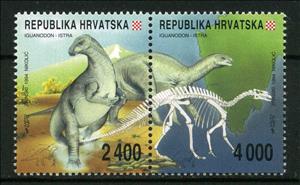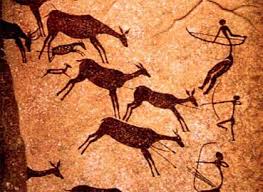Se-tenant: Iguanodon, Landscape and Map of Istria (Croatia 1994)
Iguanodon, Landscape and Map of Istria (Croatia 1994)
07 March (Croatia ) within release Dinosaurs Findings on the West Coast of Istria goes into circulation Se-tenant Iguanodon, Landscape and Map of Istria face value 6,400 Croatian dinar
| Se-tenant Iguanodon, Landscape and Map of Istria in catalogues | |
|---|---|
| Michel: | Mi: HR 268-269 |
| Stamp Number: | Sn: HR 185 |
| AFA number: | AFA: HR S284-285 |
Se-tenant is square format.
Also in the issue Dinosaurs Findings on the West Coast of Istria:
- Stamp - Iguanodon face value 2400;
- Stamp - Iguanodon face value 4000;
- First Day Cover - Iguanodon, Landscape and Map of Istria face value 6400;
- Mini Sheet - Iguanodon, Landscape and Map of Istria face value 64000;
- Se-tenant - Iguanodon, Landscape and Map of Istria face value 6,400;
Se-tenant Iguanodon, Landscape and Map of Istria it reflects the thematic directions:
Animals are multicellular, eukaryotic organisms of the kingdom Animalia (also called Metazoa). All animals are motile, meaning they can move spontaneously and independently, at some point in their lives. Their body plan eventually becomes fixed as they develop, although some undergo a process of metamorphosis later on in their lives. All animals are heterotrophs: they must ingest other organisms or their products for sustenance.
A map is a symbolic depiction emphasizing relationships between elements of some space, such as objects, regions, or themes. Many maps are static, fixed to paper or some other durable medium, while others are dynamic or interactive. Although most commonly used to depict geography, maps may represent any space, real or imagined, without regard to context or scale, such as in brain mapping, DNA mapping, or computer network topology mapping. The space being mapped may be two dimensional, such as the surface of the earth, three dimensional, such as the interior of the earth, or even more abstract spaces of any dimension, such as arise in modeling phenomena having many independent variables. Although the earliest maps known are of the heavens, geographic maps of territory have a very long tradition and exist from ancient times. The word "map" comes from the medieval Latin Mappa mundi, wherein mappa meant napkin or cloth and mundi the world. Thus, "map" became the shortened term referring to a two-dimensional representation of the surface of the world.
Prehistory, also called pre-literary history, is the period of human history between the first known use of stone tools by hominins c. 3.3 million years ago and the beginning of recorded history with the invention of writing systems. The use of symbols, marks, and images appears very early among humans, but the earliest known writing systems appeared c. 5,200 years ago. It took thousands of years for writing systems to be widely adopted, with writing spreading to almost all cultures by the 19th century. The end of prehistory therefore came at different times in different places, and the term is less often used in discussing societies where prehistory ended relatively recently.



